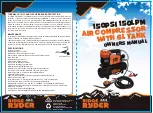
SB-170-9 RUS
5
SB-170-9
25
5.4.2 CM-SW-01
Standard for all CSW105 compressors
The compressor module integrates the entire electronic
periphery of the compressor: It allows monitoring the
essential operating parameters of the compressor: mo-
tor and discharge gas temperature, phase and rotation
direction monitoring, oil supply and application limits
and thus protects the compressor from operation under
critical conditions. For further information, see Tech-
nical Information ST-150.
!
!
NOTICE
The compressor module may be damaged or
fail!
Never apply any voltage to the terminals of CN7
to CN12 – not even for test purposes!
The voltage applied to the terminals of CN13
must not exceed 10 V!
The voltage applied to terminal 3 of CN14 must
not exceed 24 V! Do no apply voltage to the
other terminals!
The following components are completely installed and
wired in the state of delivery:
• Slider position indicator.
• Oil monitoring (OLC-D1).
• Solenoid valves for capacity control and V
i
.
• Discharge gas temperature sensor.
• Low pressure and high pressure transmitter.
Modification to these components or their wiring is not
required and should not be done without consulting
BITZER.
The following components are not installed and wired in
the state of delivery and need to be connected:
• Motor temperature monitoring (PTC sensor in motor
winding).
• Phase monitoring (in case of a phase failure or inad-
missibly high phase asymmetry).
The compressor module internally supplies voltage to
the peripheral devices (solenoid valves, oil monitoring
device and slider position indicator) and to the terminal
strips CN7 to CN12.
Please refer to the Technical Information ST-150 for in-
formation on all connections.
5.4.3 SE-i1
This protection device with extended monitoring func-
tions can be used as an option for all HS.53 .. HS.85
compressors and CSH and CSW compressors.
Monitoring functions:
• Temperature monitoring.
• Monitoring of the PTC control circuit to detect any
short-circuit or line break/sensor failure.
• Rotation direction monitoring.
• Monitoring of phase failure and asymmetry.
• Monitoring of the maximum cycling rate.
For further information, see Technical Information
CT-110.
5.4.4 SE-E2
Optional protection device for operation with frequency
inverter and soft starter (for a ramp time shorter than
1 s).
• Dimensions and integration in the control identical to
SE-E1.
• Suitable for all CS. compressors.
• Monitoring functions are basically identical to those
of SE-E1. However, the SE-E2 monitors phase fail-
ure during the entire running time of the compressor.
For further information, see Technical Information
ST-122.
5.4.5 Monitoring of the oil circuit
• For short circuits without liquid injection (LI) for addi-
tional cooling and for small system volume and small
refrigerant charge: Indirect monitoring with oil tem-
perature sensor (standard)
!
!
NOTICE
Lack of oil leads to a too high increase in tem-
perature.
Risk of damage to the compressor!
• For circuits with liquid injection (LI) for additional
cooling and / or for great system volume as well as
parallel compounding: Monitor oil level directly with
opto-electronic oil level monitoring (option), see
chapter Opto-electronic oil level monitoring OLC-D1-
S, page 26. The connection is on the compressor
housing, see chapter Connections and dimensional
drawings, page 14, position 8.
SB-170-9
5
For work on the compressor once it has been
commissioned
WARNING
The compressor is under pressure!
Serious injuries are possible.
Depressurize the compressor!
Wear safety goggles!
CAUTION
Surface temperatures of more than 60°C or be-
low 0°C.
Risk of burns or frostbite.
Close off accessible areas and mark them.
Before performing any work on the compressor:
switch it off and let it cool down.
For work on the electrical and/or electronic system
WARNING
Risk of electric shock!
Before working on the terminal box, module
housing and electrical lines: Switch off the main
switch and secure it against being switched on
again!
Close the terminal box and the module housing
before switching on again!
!
!
NOTICE
The compressor module may be damaged or
fail!
Never apply any voltage to the terminals of CN7
to CN12 – not even for test purposes!
The voltage applied to the terminals of CN13
must not exceed 10 V!
The voltage applied to terminal 3 of CN14 must
not exceed 24 V! Do no apply voltage to the
other terminals!
3 Application ranges
Permitted refrigerants
(other refrigerants on request)
CSH65 .. CSH95, CSW65 ..
CSW95:
R134a, R407C, R450A, R513A,
R1234yf, R1234ze(E)
CSW105: R134a, R450A,
R513A, R1234yf
CSH76 .. CSH96:
R134a, R450A,
R513A, R1234yf,
R1234ze(E)
CSH65 .. CSH95,
CSW65 .. CSW95,
CSK61:
R22
Oil charge
CSH: BSE170
CSW: BSE170L
BSE170L
B320SH
Application limits
CSH: see brochure SP-171 and BITZER SOFTWARE
CSW: see brochure SP-172 and BITZER SOFTWARE
Tab. 1: Application ranges of CS. compressors
The use of R404A and R507A and other refrigerant
blends requires individual consultation with BITZER.
Application limit for CSK61
CSK61 compressors are only approved for use with
R22 refrigerant, without ECO and LI. The application
limit goes down to -10°C. Above this value, the applica-
tion limit corresponds to that for CSH65 compressors
with R22 refrigerant.
WARNING
Risk of bursting due to counterfeit refrigerants!
Serious injuries are possible!
Purchase refrigerants only from reputable man-
ufacturers and reliable distributors!
Risk of air penetration during operation in the vacuum
range
!
!
NOTICE
Potential chemical reactions as well as in-
creased condensing pressure and rise in dis-
charge gas temperature.
Avoid air penetration!
WARNING
A critical shift of the refrigerant ignition limit is
possible.
Avoid air penetration!






































